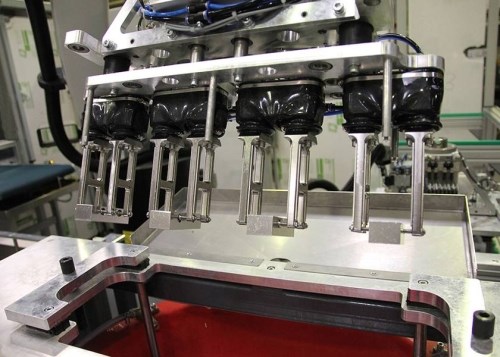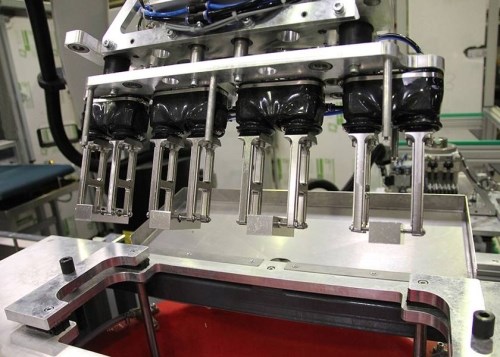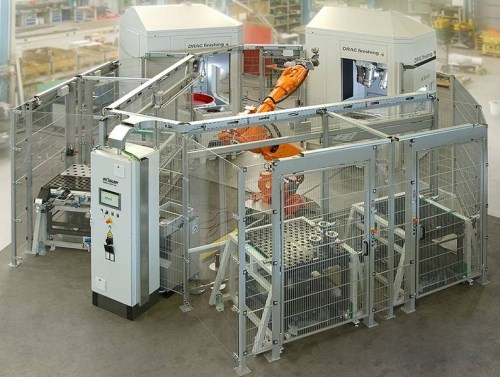Mass Finishing in a Less Frenetic Fashion
Finishing systems with robotic loading capability can enable complex parts to be deburred, polished or smoothed without bumping into each other and causing them to be damaged.


The vast majority of mass finishing processes I’ve encountered in shops use a large vibratory tumbler inside of which a mishmash of workpieces and finishing media swirl around in contact with one another, serving to smooth, deburr, radius or polish the workpieces.
While this might be perfectly fine for some applications, what about parts that have complex shapes or delicate features that could become damaged if they were to bump into each other during such a frenetic finishing process? For these, an alternate method of introducing parts to finishing media might be required to prevent potential damage from occurring.
In fact, Rösler Metal Finishing suggests three automated options to completely finish workpieces such as these or to perform targeted finishing of specific surfaces in a high-production environment, leveraging the advantages of robotic handling.
The first is shown above. Called Surf Finisher, it uses one or two robots with custom grippers to pick workpieces from a conveyor, immerse them into a rotating work bowl filled with the appropriate grinding or polishing media, then return them to an outbound conveyor. The work bowl is available in different sizes to enable the finishing of a single, large parts or the simultaneous finishing of multiple smaller parts. The robot can guide the workpieces through the processing media in pre-programmed movements including defined treatment angles, different immersion depths and rotary motion to enable the targeted finishing of specific surface areas.
The work bowl with processing media is also rotating at a speed of up to 80 rpm (actual speed is determined by the types of workpieces and finish requirements). The robotic movement combined with the work bowl rotation creates a “surfing” effect with very high pressure between workpiece and media. This concurrent, intensive pressure is said to create a surface smoothing effect in a relatively short amount of time, achieving Ra finishes to 0.04 micron.

The second, shown above, also uses one or more robots that perform two functions: material handling and programmed movement of workpieces through the processing media. For this system, which is called High-Frequency-Finisher (HFF), the media for wet or dry processing within the work bowl are agitated by vibration with a speed as high as 3,000 rpm. The robot with custom gripper immerses the workpieces into the agitated media, and the dual movement of the robot and media results in a high-pressure, highly intensive treatment of the parts completed in fast cycle times.

The third, shown above, is a new version of Rösler’s Drag Finishing system that includes automatic workpiece loading/unloading. In fact, this automated system was developed for Walter AG, multinational cutting tool manufacturer, to enable the company to automatically deburr a variety of different sized tool bodies instead of having its employees do that manually.
The system uses two interlinked drag finishing machines each having six working spindles served by a robot that automatically installs and removes tool bodies in and out of the spindles. The finishing process for these tools requires a safety load system that combines workpiece surface modeling and load pattern simulation. To ensure that handling errors do not occur, electronic sensors continuously monitor the pneumatic coupling system to ensure tool bodies remain safely fixtured in the spindles.
Once loaded, the tool bodies are then “dragged” through the stationary wet or dry processing media. Process parameters such as carousel and spindle speeds, immersion depth and treatment times are stored in pre-set programs in the system’s PLC. After completion of the finishing cycle, the robot removes the tool bodies, moves them to a rinse and cleaning station, and then places them onto a tray.
The company says this system can also be used to perform effective, repeatable surface finishing for items such as orthopedic implants, geared components, and aerospace and automotive components.
Related Content
Selecting a Thread Mill That Matches Your Needs
Threading tools with the flexibility to thread a broad variety of holes provide the agility many shops need to stay competitive. They may be the only solution for many difficult materials.
Read MoreAll-Around Mill Improves Productivity and Cost for Valve Job
Adopting a mill with a double-negative rake and pockets compatible with multiple insert geometries enabled Progressive Metal Service to increase feed and lower scrap rates for a valve.
Read MoreChoosing Your Carbide Grade: A Guide
Without an international standard for designating carbide grades or application ranges, users must rely on relative judgments and background knowledge for success.
Read More10 Tips for Titanium
Simple process considerations can increase your productivity in milling titanium alloys.
Read MoreRead Next
The Cut Scene: The Finer Details of Large-Format Machining
Small details and features can have an outsized impact on large parts, such as Barbco’s collapsible utility drill head.
Read More3 Mistakes That Cause CNC Programs to Fail
Despite enhancements to manufacturing technology, there are still issues today that can cause programs to fail. These failures can cause lost time, scrapped parts, damaged machines and even injured operators.
Read More
.jpg;width=70;height=70;mode=crop)







.png;maxWidth=300;quality=90)

















